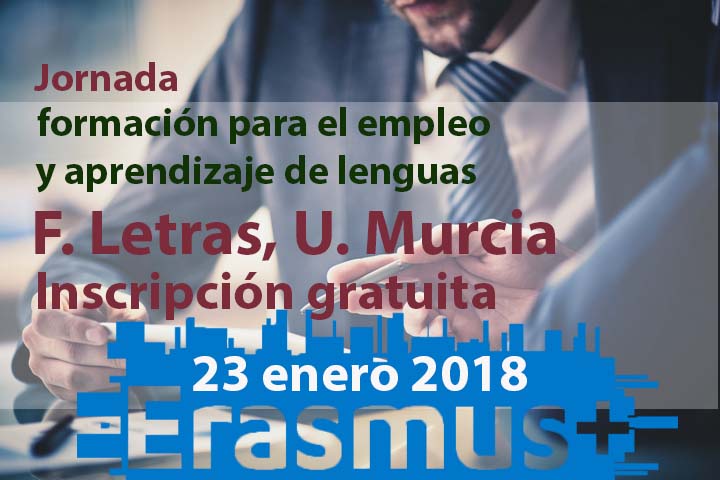I Jornadas Vocational Guidance In Clil (VGCLIL). Universidad de Murcia. 23 October, 2018.
CLIL en contextos profesionales.Acceso a la presentación online.
Links:
Languages for the future. British Council 2017.
The value of languages. Cambridge Language Sciences. 2017.
SMEs language survey. British Academy. 2015
Algunos datos sobre VGCLIL (Prof. Purificación Sánchez Hernández, Coordinadora en España VGCLIL)
Sitio web: http://vgclil.eu/index.php
Twitter: @VGCLILproject
Plataforma de formación: http://vgclil.eu/pages/page.php?id=4
Referencias sobre CLIL, EMI e internacionalización
Dafouz, E., & Smit, U. (2014). Towards a dynamic conceptual framework for English-medium education in multilingual university settings. Applied Linguistics, 37(3), 397-415.
Referencias usadas en el proyecto VGCLIL
- Lasagabaster, D., & Doiz, A. (2016). CLIL students’ perceptions of their language learning process: Delving into self-perceived improvement and instructional preferences. Language Awareness, 25(1), 110. doi:10.1080/09658416.2015.1122019
- Bamond Lozano, V. M., & Strotmann, B. (2015). Internationalizing higher education: Language matters. TESOL Quarterly, 49(4), 847-857. doi:10.1002/tesq.251
- Pérez-Vidal, C., & Roquet, H. (2015). The linguistic impact of a CLIL science programme: An analysis measuring relative gains. System, doi:10.1016/j.system.2015.05.004
- Lo, Y. Y., & Macaro, E. (2015). Getting used to content and language integrated learning: What can classroom interaction reveal? The Language Learning Journal, 43(3), 239. doi:10.1080/09571736.2015.1053281
- Melinda Dooly, & Dolors Masats. (2015). A critical appraisal of foreign language research in content and language integrated learning, young language learners, and technology-enhanced language learning published in spain (2003–2012). Language Teaching, 48(3), 343-372. doi:10.1017/S0261444815000117
- Pavón Vázquez, V., Ávila López, J., Gallego Segador, A., & Espejo Mohedano, R. (2015). Strategic and organisational considerations in planning content and language integrated learning: A study on the coordination between content and language teachers. International Journal of Bilingual Education and Bilingualism, 18(4), 409-17. doi:10.1080/13670050.2014.909774
- Kong, S. (2015). Designing Content‐Language integrated learning materials for late immersion students. TESOL Journal, 6(2), 302-331. doi:10.1002/tesj.151
- Vilma Bijeikienė, & Daiva Pundziuvienė. (2015). Implementation of CLIL in lithuanian secondary schools: A case study. Coactivity: Philology, 23(1), 1-13. doi:10.3846/cpe.2015.252
- Lo, Y. Y., & Lin, A. M. Y. (2015). Special issue: Designing multilingual and multimodal CLIL frameworks for EFL students. International Journal of Bilingual Education and Bilingualism, 18(3), 261-269. doi:10.1080/13670050.2014.988111
- Jill Surmont, Esli Struys, & Thomas Somers. (2015). Creating a framework for a large-scale implementation of content and language integrated learning: The first steps. European Journal of Language Policy, 7(1), 29.
- Reljić, G., Ferring, D., & Martin, R. (2015). A meta-analysis on the effectiveness of bilingual programs in europe. Review of Educational Research, 85(1), 92-128.
- Wei, R., & Feng, J. (2015). Implementing CLIL for young learners in an EFL context beyond europe. English Today, 31(1), 55-60. doi:10.1017/S0266078414000558
- Julian Chapple. (2015). Teaching in english is not necessarily the teaching of english. International Education Studies, 8(3), 1. doi:10.5539/ies.v8n3p1
- Yilmaz Satilmis, Doganay Yakup, Guvercin Selim, & Islam Aybarsha. (2015). Teaching concepts of natural sciences to foreigners through content-based instruction: The adjunct model. English Language Teaching, 8(3), 97. doi:10.5539/elt.v8n3p97
- María Ángeles Martín del Pozo, & Débora Rascón Estébanez. (2015). Textbooks for content and language integrated learning: Policy, market and appropriate didactics? Foro De Educación, 13(18), 123-141. doi:10.14516/fde.2015.013.018.007
- Heras, A., & Lasagabaster, D. (2015). The impact of CLIL on affective factors and vocabulary learning. Language Teaching Research, 19(1), 70-88. doi:10.1177/1362168814541736
- Llinares, A., & Pascual Peña, I. (2015). A genre approach to the effect of academic questions on CLIL students’ language production. Language and Education, 29(1), 15-30. doi:10.1080/09500782.2014.924964
- Llinares, A. (2015). Integration in CLIL: A proposal to inform research and successful pedagogy. Language, Culture and Curriculum, 28(1), 58-73. doi:10.1080/07908318.2014.1000925
- Cenoz, J. (2015). Content-based instruction and content and language integrated learning: The same or different? Language, Culture and Curriculum, 28(1), 8-24. doi:10.1080/07908318.2014.1000922
- Lin, A. M. Y. (2015). Conceptualising the potential role of L1 in CLIL. Language, Culture and Curriculum, 28(1), 74-89. doi:10.1080/07908318.2014.1000926
- Meyer, O., Coyle, D., Halbach, A., Schuck, K., & Ting, T. (2015). A pluriliteracies approach to content and language integrated learning – mapping learner progressions in knowledge construction and meaning-making. Language, Culture and Curriculum, 28(1), 41-57. doi:10.1080/07908318.2014.1000924
- Ruiz de Zarobe, Y., & Cenoz, J. (2015). Way forward in the twenty-first century in content-based instruction: Moving towards integration. Language, Culture and Curriculum, 28(1), 90-96. doi:10.1080/07908318.2014.1000927
- Martínez Adrián, M., & Gutiérrez Mangado, M. J. (2015). Is CLIL instruction beneficial in terms of general proficiency and specific areas of grammar? Journal of Immersion and Content-Based Language Education, 3(1), 51-76. doi:10.1075/jicb.3.1.03adr
- Lorenzo, F., & Rodríguez, L. (2014). Onset and expansion of L2 cognitive academic language proficiency in bilingual settings: CALP in CLIL. System, 47, 64-72. doi:10.1016/j.system.2014.09.016
- Khan, S. (2014). Integration of theory and practice in CLIL. System, 47, 177-179. doi:10.1016/j.system.2014.10.004
- Lin, C., & Zhang, J. (2014). Investigating correspondence between language proficiency standards and academic content standards: A generalizability theory study. Language Testing, 31(4), 413-431. doi:10.1177/0265532213520304
- Jun Lei, & Guangwei Hu. (2014). Is english-medium instruction effective in improving chinese undergraduate students’ english competence? International Review of Applied Linguistics in Language Teaching, 52(2), 99-126. doi:10.1515/iral-2014-0005
- Taguchi, N. (2014). English-medium education in the global society: Introduction to the special issue. IRAL – International Review of Applied Linguistics in Language Teaching, 52(2), 89. doi:10.1515/iral-2014-0004
- Baker, F. S. (2014). The roles of language in CLIL. International Journal of Bilingual Education and Bilingualism, 17(4), 500-503. doi:10.1080/13670050.2013.809911
- Cenoz, J., Genesee, F., & Gorter, D. (2014). Critical analysis of CLIL: Taking stock and looking forward. Applied Linguistics, 35(3), 243-262. doi:10.1093/applin/amt011
- Javier Barbero, & Jesús Ángel González. (2014). Chapter ten CLIL at university: Transversal integration of english language and content in the curriculum. Utrecht Studies in Language and Communication, (28), 161.
- Felipe Jiménez, Agata Muszynska, & Maite Romero. (2014). Chapter seven: Learning processes in CLIL: Opening the door to innovation. Utrecht Studies in Language and Communication, (28), 111.
- Ignacio Pérez-Ibáñez. (2014). Chapter six: Addressing our students’ needs: Combined task-based and project-based methodology in second language and CLIL courses. Utrecht Studies in Language and Communication, (28), 97.
- Anonymous. (2014). Directory of CLIL projects and resources. Utrecht Studies in Language and Communication, (28), 189.
- Hüttner, J., & Smit, U. (2014). CLIL (content and language integrated learning): The bigger picture. A response to: A. Bruton. 2013. CLIL: Some of the reasons why … and why not. system 41 (2013): 587–597. System, 44, 160-167. doi:10.1016/j.system.2014.03.001
- Banegas, D. L. (2014). An investigation into CLIL-related sections of EFL coursebooks: Issues of CLIL inclusion in the publishing market. International Journal of Bilingual Education and Bilingualism, 17(3), 345-359. doi:10.1080/13670050.2013.793651
- Muñoz-Luna, R. (2014). From drills to CLIL: The paradigmatic and methodological evolution towards the integration of content and foreign language. Profile: Issues in Teachers’ Professional Development, 16(1), 167-180. doi:10.15446/profile.v16n1.37843
- Heine, L. (2014). Models of the bilingual lexicon and their theoretical implications for CLIL. The Language Learning Journal, 42(2), 225-237. doi:10.1080/09571736.2014.889973
- Kramsch, C. (2014). Teaching foreign languages in an era of globalization: Introduction. The Modern Language Journal, 98(1), 296-311. doi:10.1111/j.1540-4781.2014.12057.x
- Lo Bianco, J. (2014). Domesticating the foreign: Globalization’s effects on the Place/s of languages. The Modern Language Journal, 98(1), 312-325. doi:10.1111/j.1540-4781.2014.12063.x
- Richards, J. C., & Reppen, R. (2014). Towards a pedagogy of grammar instruction. RELC Journal, 45(1), 5-25.
- Aguilar, M., & Muñoz, C. (2014). The effect of proficiency on CLIL benefits in engineering students in Spain. International Journal of Applied Linguistics, 24(1), 1-18. doi:10.1111/ijal.12006
- Hu, G., Li, L., & Lei, J. (2014). English-medium instruction at a Chinese university: Rhetoric and reality. Language Policy, 13(1), 21-40. doi:10.1007/s10993-013-9298-3
- Anderson, L.W., Krathwohl, D.R., Airasian, P.W., Cruikshank, K.A., Mayer, R.E., Pintrich, P.R., Raths, J., Wittrock, M.C. (2001). A Taxonomy for Learning, Teaching, and Assessing: A revision of Bloom’s Taxonomy of Educational Objectives. New York: Pearson, Allyn & Bacon.
- Coyle, D., Hood, P., & Marsh, D. (2010). Content and language integrated learning. Ernst Klett Sprachen.
- Clark, R., Chopeta, L. (2004). Graphics for Learning : Proven Guidelines for Planning, Designing, and Evaluating Visuals in Training Materials . San Francisco: Jossey-Bass/Pfeiffer.


